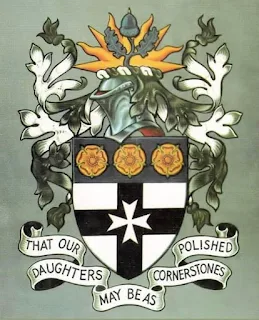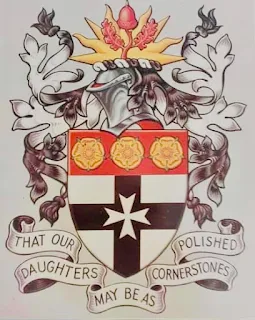.png) |
| The logo for the 36th Congress created by the talented Matthew Alderman. |
The theme for the 36th Congress, "origins, journeys, destinations," informs the programs and presentations this year, while perfectly embodying the American spirit and history at the same time. Genealogy and heraldry are equally balanced within the programming, forming the two core subjects. In terms of heraldry, proposals were requested to address questions such as how does heraldry create, preserve, or reinforce group identity and proposals were to align with this theme.
This past Fall, I submitted a proposal to the Congress' Scientific Committee on la Rose's heraldic work for numerous Roman Catholic religious communities and their corresponding academic institutions they established. My tailored focus on these particular communities thematically worked well, as they shared European origins and moved throughout the US in the early 20th century as a result of their missionary work. In my mind, no proceedings on heraldry occurring in Boston would be complete without examining la Rose's work.
I labored over the title and abstract, knowing I had but one shot at giving la Rose his proper place in the annals of the Congress. Ultimately, I chose, "The Heraldic Carpenter: Pierre de Chaignon la Rose Fashioning New American Identity," honoring la Rose's role as a heraldic carpenter of sorts, effectively constructing designs that honored the origins of these communities while identifying their destinations at the same time. A certain reader will happily note that I no longer refer to la Rose as a "herald," acquiescing to reason and sound argument. My thinking continues to evolve on the use of this particular noun.
With a 300 word limit, I submitted the following abstract (in 290 words, no less):"Corporate heraldry in the United States experienced a significant revival during the early 20th Century, fueled in part by the missionary work of several Roman Catholic religious communities and their need to authentic diplomas for newly established educational institutions. These religious communities, founded in Europe, required a new American identity and placed their faith in the capable hands of Pierre de Chaignon la Rose (1872-1941) of Harvard.
"As the nation’s leading expert in ecclesiastical heraldry, la Rose assiduously built his reputation within the Roman Catholic Church following his landmark commission for arms in 1910 for the Archdioceses of Baltimore and Boston.
"Through a thematic analysis of 250 designs of corporate arms by la Rose, this paper will examine how the designer constructed a framework without any precedence in the US to illustrate the ancestral origins of several Roman Catholic religious communities while accomplishing unification and differencing in their arms at the same time.
"Void of any heraldic authority in the US, la Rose built his methods based on the ancient rules and customs of heraldry, while forging a new pathway for corporate arms in America. La Rose fashioned new identity for these communities by employing unique charges representing their European foundations for unification, while differencing their arms based on their destinations, such as new colleges or branches of the community.
"La Rose filled a critical need in the US and was the first herald to employ these methods to create and preserve group identity while setting a high standard for best practices in designing corporate arms."Through the brilliance of la Rose’s designs for these communities, he would render clear and perspicuous heraldry and many are still used today for identification."The result? I'm going to Boston!
When I received the official notification, I nearly fell down. I was filled with lots of emotions. It's rather quite difficult to render words that do justice to my long and winding journey researching la Rose. I never imaged 10 years ago where I would be standing today.
All in all, I'm feeling the magnitude of what this opportunity means for me, and I promise to not let la Rose down.








.png)








